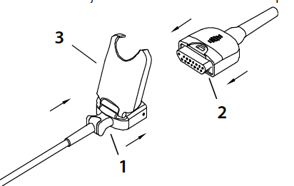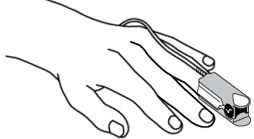SpO2 Monitoring
This short video will show you how to use the SpO2 monitoring operation on your corpuls3 defibrillator. Software Version 2.3.2
Information on SpO2 Monitoring
- Oximetry is a non-invasive monitoring method for continuous measurement of arterial oxygen saturation (SpO2) in the blood.
- The specific reduction in the absorbance of oxygenated and deoxygenated haemoglobin is measured with light of different wavelengths by means of a photo sensor.
- Comparison of the values yields the SpO2 values as a percentage.
- Additionally, the oximetry measures peripheral pulse rate (PR) per minute and perfusion index (PI) in percentage.
Preparing for SpO2 Monitoring

Connect the oximetry sensor to the intermediate cable as shown in the diagram above.
Ensure that the intermediate cable is plugged into the patient.

The sensor should be applied to the patient's ring finger or middle finger on the patient's non-dominant hand where possible.
Refer to the User Instructions for appropriate application of the sensor of choice.
Performing SpO2 Measurement
Measurements begin automatically after the sensor has been attached, however there will be a few seconds delay before the pleth appears on the screen (dependant on configured averaging time).

When artifact, a low intensity signal, a low perfusion index is displayed, or the measurement does not appear plausible (e.g. due to movement artifact, light pollution, and phototherapy), always check the patient’s vital signs and ensure optimal positioning of the SpO2 sensor.
A low confidence of the measured value is indicated by a question mark ? in place of the alarm symbol.
Perfusion Index (PI)
- The PI represents the pulsating part in relation to the non-pulsating part of the oximetry signal
- PI ranges from a value of 0.02% (very weak pulse strength) to 20% (very strong pulse strength)
- The PI value will vary between different application sites and from patient to patient:
- A PI value above 0.07% supports the validity of the SpO2 and pulse rate
- A PI value below 0.07% indicates a deterioration in perfusion and therefore the SpO2 and pulse rate may not be reliable
Averaging Time
Stability of SpO2 values is also a good indicator of signal quality and is influenced by the averaging time selected. The longer the averaging time, the more stable the readings, due to a dampened response as the signal is averaged over a longer timeframe. However, longer averaging times delay the response of the oximeter and reduce the measured variations of SpO2 and pulse rate. The averaging times can be set to one of seven levels with 8 seconds as a general default level.
FastSat®
The FastSat® mode tracks rapid changes in arterial SpO2 saturation with high fidelity. This is particularly useful during intubation, as it enables more accurate and safer patient monitoring.
Sensitivity
The sensitivity of the oximeter can be adjusted to the needs of the patient monitoring situation in three 'modes'.
Normal: The recommended sensitivity for continuous patient monitoring
Adaptive Probe Off Detection® (APOD®): Recommended sensitivity and mode for situations where a high probability of the sensor detachment is likely and in care areas where patients are not visually continuously monitored. APOD® offers a safe and fast detection of erroneous pulse rate and arterial oxygen saturation readings when a sensor becomes inadvertently detached from a patient.
Maximum Sensitivity (MAX): Recommended for patients with low perfusion in general or when the "Low perfusion" message is displayed on the screen in APOD® or normal sensitivity mode. This mode is only recommended for care areas where patients are visually continuously monitored.
🚨 When using MAX mode, if the sensor becomes detached from a patient, erroneous pulse rate and arterial saturation reading notification will be compromised.
Use the link below to access the above information as a downloadable PDF: